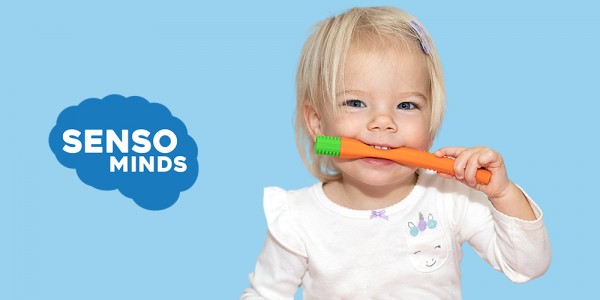A Guide To Sensory Input For Teething Babies By Senso Minds

What Is Sensory Input?
Sensory input is apparent in five different forms: taste, smell, sound, touch, and hearing. Vestibular and proprioception are two of the lesser-known senses. They control everything to do with movement, balance, and position. Being under-responsive (lethargic) to sensory stimulation or over-responsive (sensory defensive) can cause children to experience “behavioral issues.” Children and babies who struggle to process sensory input correctly can seem a little too loud or avoid particular touches and smells.
How Babies Experience Sensory Input
Since babies are experiencing everything for the first time, it is vital to take note of how they respond to certain things. Every time a baby feeds, touches a new texture or smells something different, they are awakening a sensory input. They need to be provided with activities or objects to help stimulate these senses.
For example, when it comes to tactile stimulation (touch), babies learn about the property of objects with their hands and mouth. Providing them with a range of textures such as food, and toys of different shapes and sizes will be highly effective, such as textured baby teething tubes. Sensory teething tubes for babies feature various textures such as bumps and ridges. The fun, bright colors mean the baby teething toy is excellent for both sight and touch stimulation, as well as being safe and easy to chew.
Interoception is the sense of hunger and pain; two things babies experience when teething. There isn’t much that can combat discomfort, other than a constant routine and baby teething toys or teething tubes. Babies will soon grow out of teething, but it is essential to help soothe them while they’re experiencing it. Sensory teething tubes for babies provide a sense of relief and stimulate the tactile and visual senses. Having flexible, easy to hold teething tubes with bright colors means it will always be the go-to for babies alike.
From Teething To Chewing
As children get older, they usually grow out chewing objects once the teething begins to subside. For others, they continue to seek out oral stimulation and may turn to chewing on pencils, clothes, and hair. Chewing is more apparent within children who are orally defensive or fussy eaters. Instead of discouraging it, it is better to find a safe and clean alternative. Since teething toys were specially made for babies, it is better to find a product aimed towards older children, such as sensory chew necklaces. The market offers a whole range of chew necklaces and chewelry, which provide various textures and bright colors. Chew necklaces are great for simulating sight and touch, on top of relieving any anxiety and stress children may have.
Conclusion
All in all, sensory input is far more important than people think. Giving babies and children activities to help stimulate their senses is vital. With the help of baby teething toys, chewies, and sensory chew necklaces, the road to a calmer future has been paved.
Media Contact
Company Name: Senso Minds
Contact Person: AJ Grewal
Email: Send Email
Phone: 16162273676
Country: Canada
Website: https://sensominds.com/

